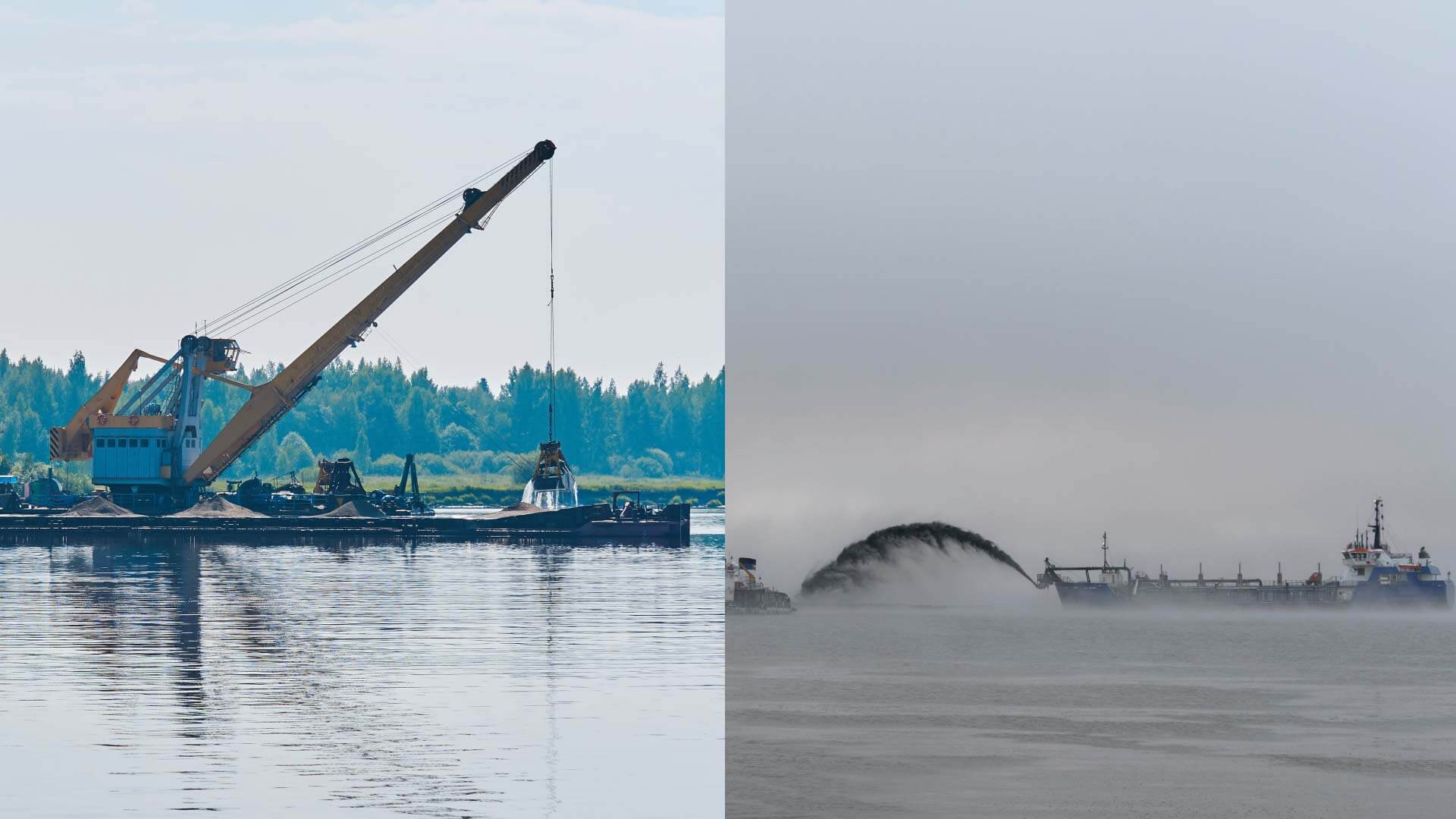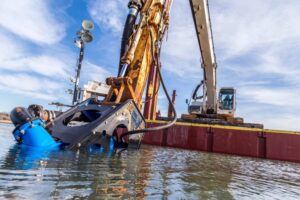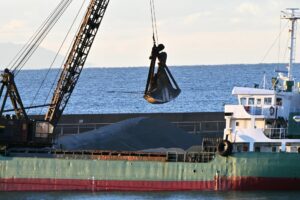Dredging is vital for maintaining waterways, supporting mining operations, and restoring aquatic ecosystems. Over time, sediment buildup can restrict water flow, create navigational hazards, and negatively impact marine life. Dredging involves removing sediment and debris to maintain water depth, improve water quality, and prevent flooding. Effective sediment removal helps ports and harbors remain functional, supports shipping operations, and protects infrastructure from erosion and storm damage.
There are two primary types of dredging equipment used for sediment removal: hydraulic and mechanical. Hydraulic dredging machinery uses suction and water pressure to extract sediment and transport it through a pipeline to a designated disposal site. This method is ideal for handling fine sediment and large-scale projects. On the other hand, mechanical dredge equipment relies on physical excavation using buckets, backhoes, or clamshells. It is more effective for compacted material and small-scale projects requiring precision.
Choosing between hydraulic and mechanical dredge equipment depends on several factors, including sediment type, project size, and environmental impact. Pond dredging equipment is often mechanical due to the shallow water and confined space typical of pond environments. This blog will compare hydraulic and mechanical dredging machinery, highlighting their benefits, limitations, and best-use scenarios to help you determine the right solution for your project.
Understanding Dredging Equipment
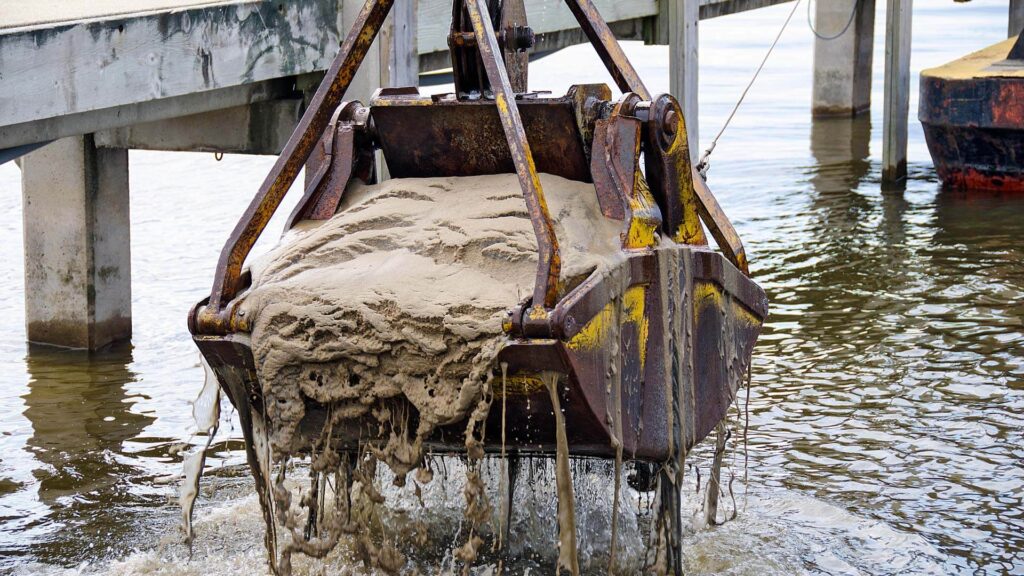
Dredging equipment refers to specialized machines used to remove sediment, debris, and other materials from the bottom of water bodies such as rivers, lakes, harbors, and coastal areas. This equipment is essential for maintaining navigable waterways, preventing flooding, supporting mining operations, and restoring aquatic ecosystems. Over time, sediment buildup can restrict water flow, reduce water depth, and negatively impact marine life. Dredge equipment helps address these challenges by efficiently removing unwanted material and transporting it to a designated disposal site.
Selecting the right dredge equipment is crucial for the success of any dredging project. The type of equipment used depends on several factors, including the sediment type, water depth, and environmental considerations. For instance, fine materials like silt and sand are often handled more efficiently with hydraulic dredging machinery, while compacted or rocky material requires the strength and precision of mechanical dredging machinery. Understanding these differences helps ensure that the equipment performs effectively and minimizes environmental impact.
Dredging projects can vary significantly in scale and complexity, which is why selecting the right equipment for each application is essential. Common types of dredging projects include:
- Port and harbor maintenance – Dredging helps keep shipping channels open and ensures safe passage for vessels by removing sediment buildup.
- River and lake restoration – Removing sediment and debris improves water flow, prevents flooding, and restores natural habitats.
- Mining operations – Dredging is used to extract valuable materials such as sand, gravel, and precious metals from riverbeds and other water bodies.
- Pond dredging equipment – Small-scale projects, such as pond maintenance, require specialized equipment designed for shallow water and confined spaces. Pond dredging equipment is typically smaller and more maneuverable, making it ideal for localized sediment removal.
Several key factors influence the selection of dredge equipment for a project:
- Sediment type – The composition of the sediment (sand, silt, clay, or gravel) determines the most effective dredging method.
- Water depth and site access: Different types of dredging machinery are required for shallow and deep-water sites to ensure efficiency and minimize disruption.
- Environmental regulations – Dredging must comply with local and international environmental standards to protect aquatic ecosystems and prevent contamination.
Choosing the right dredge equipment ensures that the project is completed efficiently, with minimal environmental impact and maximum cost-effectiveness. For smaller projects like pond cleaning, using pond dredging equipment allows for more precise sediment removal and easier maneuverability in confined areas.
What Is Hydraulic Dredging Equipment?
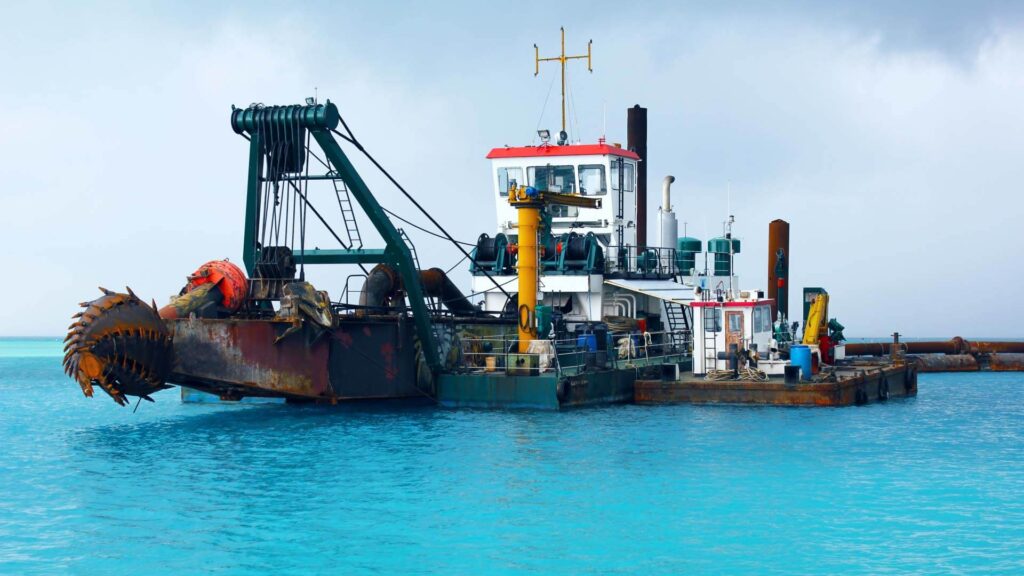
Hydraulic dredging equipment is a specialized type of dredging machinery that uses water pressure and suction to remove sediment and debris from the bottom of water bodies. This method is particularly effective for handling fine sediment, such as silt, sand, and mud, in large-scale projects. The process works by breaking up the sediment using a suction head or cutter head and then pumping the material through a discharge pipeline to a designated disposal site. Hydraulic dredging is widely used for port maintenance, river deepening, mining operations, and environmental restoration.
Key Components of Hydraulic Dredging Equipment
Hydraulic dredging machinery consists of several key components that work together to remove and transport sediment efficiently:
- Suction head or cutter head – Loosens and extracts sediment from the waterbed. A cutter head is used for harder materials, while a plain suction head is more suitable for fine sediment.
- Pump – Generates the suction force needed to transport the sediment through the pipeline.
- Discharge pipeline – Carries the dredged material to the disposal site or processing facility.
Types of Hydraulic Dredgers
There are different types of hydraulic dredge equipment designed for specific applications and sediment types:
- Cutter suction dredger: This type of dredger uses a rotating cutter head to break up hard sediment before suctioning it through the pipeline.
- Hopper dredger: This type of dredger collects sediment in an onboard hopper and transports it to an offshore disposal site. It is ideal for deep-water and large-scale projects.
- Plain suction dredger – Uses suction alone to remove loose sediment, making it ideal for fine materials like sand and silt.
Applications and Best Uses
Hydraulic dredging equipment is ideal for large-scale and deep-water projects where high production rates are needed. Common applications include:
- Deep-water dredging – Maintaining or increasing water depth in shipping channels.
- Large-scale sediment removal – Efficiently removing large volumes of sediment.
- Mining operations – Extracting valuable materials such as sand, gravel, and precious metals.
- Environmental dredging – Removing contaminated sediment while minimizing disruption to the ecosystem.
- Pond dredging equipment: Smaller hydraulic dredgers are used to maintain ponds and lagoons by removing sediment and improving water flow.
Advantages of Hydraulic Dredging
- High production rates and efficiency – Capable of removing large volumes of sediment quickly.
- Continuous operation – Hydraulic dredgers can operate for extended periods without needing to reposition.
- Ideal for fine sediment and loose material – Best suited for handling sand, silt, and mud.
- Adaptability – This can be used for both large-scale industrial projects and smaller-scale pond dredging machinery needs.
Disadvantages of Hydraulic Dredging
- Limited effectiveness with heavy or compacted material – Hydraulic dredge equipment may struggle with rock or clay.
- Higher initial investment costs – Setting up hydraulic dredging equipment requires significant infrastructure, including pumps and pipelines.
What Is Mechanical Dredging Equipment?
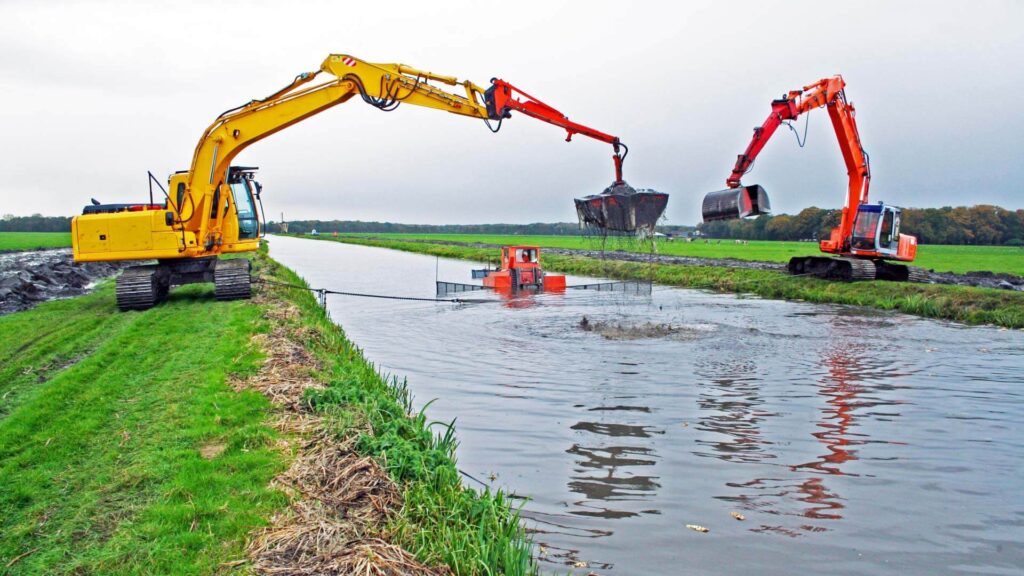
Mechanical dredging machinery is a type of dredging machinery that relies on physical force to excavate and remove sediment from the bottom of water bodies. Unlike hydraulic dredging, which uses suction and water pressure, mechanical dredging involves the direct removal of sediment using buckets, clamshells, or excavator arms. This method is particularly effective for handling heavy, compacted material and for projects requiring high precision. Mechanical dredging is commonly used for port and harbor maintenance, removing contaminated material, and small-scale projects such as pond cleaning.
Key Components of Mechanical Dredging Equipment
Mechanical dredging tool consists of several essential components that work together to extract and transport sediment:
- Bucket or excavator arm – Used to dig into the sediment and lift it from the waterbed.
- Clamshell or backhoe – Mechanical tools attached to the dredger that grip and remove material.
- Barge or hopper – Holds the dredged material until it can be transported to a disposal site.
These components make mechanical dredging ideal for removing heavy and compacted sediment, including gravel, clay, and rock. Unlike hydraulic methods, mechanical dredging allows for more precise excavation and better control over sediment removal.
Types of Mechanical Dredgers
There are several types of mechanical dredge equipment, each suited for specific materials and project requirements:
- Backhoe dredger: This machine excavates sediment using a mechanical arm and a bucket. It is ideal for compacted or rocky material.
- Clamshell dredger: This device uses a clamshell bucket to scoop sediment from the waterbed. It is effective for deep or hard-to-reach areas.
- Bucket ladder dredger: This type of dredger uses a continuous chain of buckets to remove sediment. It is best for large-scale excavation and handling tough materials.
Applications and Best Uses
Mechanical dredging equipment is well-suited for a variety of applications, including:
- Harbor and port maintenance – Removing sediment buildup to maintain navigational channels.
- Removing heavy and compacted sediment – Effective for excavating clay, gravel, and rock.
- Precision dredging – Ideal for detailed excavation and controlled removal of contaminated material.
- Pond dredging equipment – Mechanical dredgers are commonly used for small-scale pond maintenance due to their precision and ability to operate in confined spaces. Pond dredging equipment allows for targeted removal of sediment without disturbing the entire water body.
Advantages of Mechanical Dredging
- High accuracy and precision – Mechanical dredgers allow for precise control over sediment removal, making them ideal for projects requiring careful excavation.
- Effective for hard or compacted material – Unlike hydraulic dredgers, mechanical dredge equipment can handle tough materials like rock and clay.
- Suitable for shallow water and tight spaces – Mechanical dredging equipment can operate in confined areas, including small ponds and narrow channels.
Disadvantages of Mechanical Dredging
- Lower production rates compared to hydraulic dredging – Mechanical dredging is typically slower and less efficient for large-scale projects.
- Disruption to aquatic ecosystems due to sediment disturbance – Mechanical excavation can create turbidity and disturb marine life.
Mechanical dredging equipment is ideal for projects that require precision and the removal of heavy or compacted material. While it may have lower production rates compared to hydraulic dredging, its ability to handle tough sediment and work in confined spaces makes it the preferred choice for specialized projects. For small-scale projects, pond dredging equipment provides the flexibility and precision needed to maintain water quality and navigability. Choosing the right dredge equipment ensures maximum efficiency and minimal environmental impact.
Key Differences Between Hydraulic and Mechanical Dredging Equipment

Choosing the right dredging method is essential for ensuring project efficiency and minimizing environmental impact. Hydraulic and mechanical dredging tool operates using fundamentally different methods, each suited to specific types of sediment and project requirements. Understanding the key differences between these two approaches helps determine the most effective solution for your project.
1. Method of Sediment Removal
Hydraulic dredging uses suction and water pressure to remove sediment from the waterbed. A cutter head or suction head breaks up the sediment, which is then pumped through a discharge pipeline to a disposal site. This method is ideal for large-scale sediment removal and handling fine, loose material like sand, silt, and mud.
In contrast, mechanical dredging relies on physical excavation using buckets, claws, or backhoes. The sediment is physically lifted and placed into a barge or hopper for transport. This method is more effective for compacted material and allows for greater precision in sediment removal.
2. Type of Material Handled
A hydraulic dredging tool is most effective for soft, fine sediment, such as silt and sand. The suction method efficiently removes loose material without disturbing the underlying layers.
Mechanical dredging, on the other hand, is better suited for hard or compacted materials like gravel, clay, and rock. The physical digging action of a backhoe or clamshell bucket makes it easier to handle tough materials that would clog or resist suction systems.
3. Efficiency and Production Rate
Hydraulic dredging typically offers higher production rates and faster sediment removal. It can operate continuously, making it ideal for large-scale projects.
Mechanical dredging is slower but more precise. Its ability to target specific sediment layers makes it ideal for selective dredging projects. While it may take longer to complete a project, the increased accuracy often results in cleaner, more controlled outcomes.
4. Environmental Impact
Hydraulic dredging causes less disruption to sediment layers but can increase turbidity (cloudiness) in the water. Mechanical dredging creates more disturbance but allows for greater control over material removal, reducing the spread of contaminants.
5. Project Scale and Scope
Hydraulic dredge equipment is better suited for large-scale and deep-water projects due to its continuous operation and high material handling capacity.
Mechanical dredging is more effective for small-scale and shallow-water projects. Pond dredging equipment is often mechanical, allowing for precise sediment removal in confined areas. This makes it ideal for pond maintenance and environmental restoration in smaller bodies of water.
Conclusion
Understanding the differences between hydraulic and mechanical dredging machinery is essential for selecting the right method for a dredging project. Hydraulic dredging is ideal for large-scale projects and fine sediment removal, offering high production rates and efficiency. In contrast, mechanical dredging is better suited for compacted material and projects requiring greater precision.
Choosing the right dredge equipment depends on factors such as sediment type, project scale, and environmental considerations. Hydraulic dredging is best for handling silt, sand, and mud, while mechanical dredging is more effective for gravel, clay, and rock.
Working with an experienced dredging company ensures that the most suitable equipment and methods are selected for each project. A professional team can assess site conditions, environmental impact, and project goals to recommend the best approach. For successful dredging outcomes, consult a dredging company to evaluate your project’s specific needs and select the right equipment.


